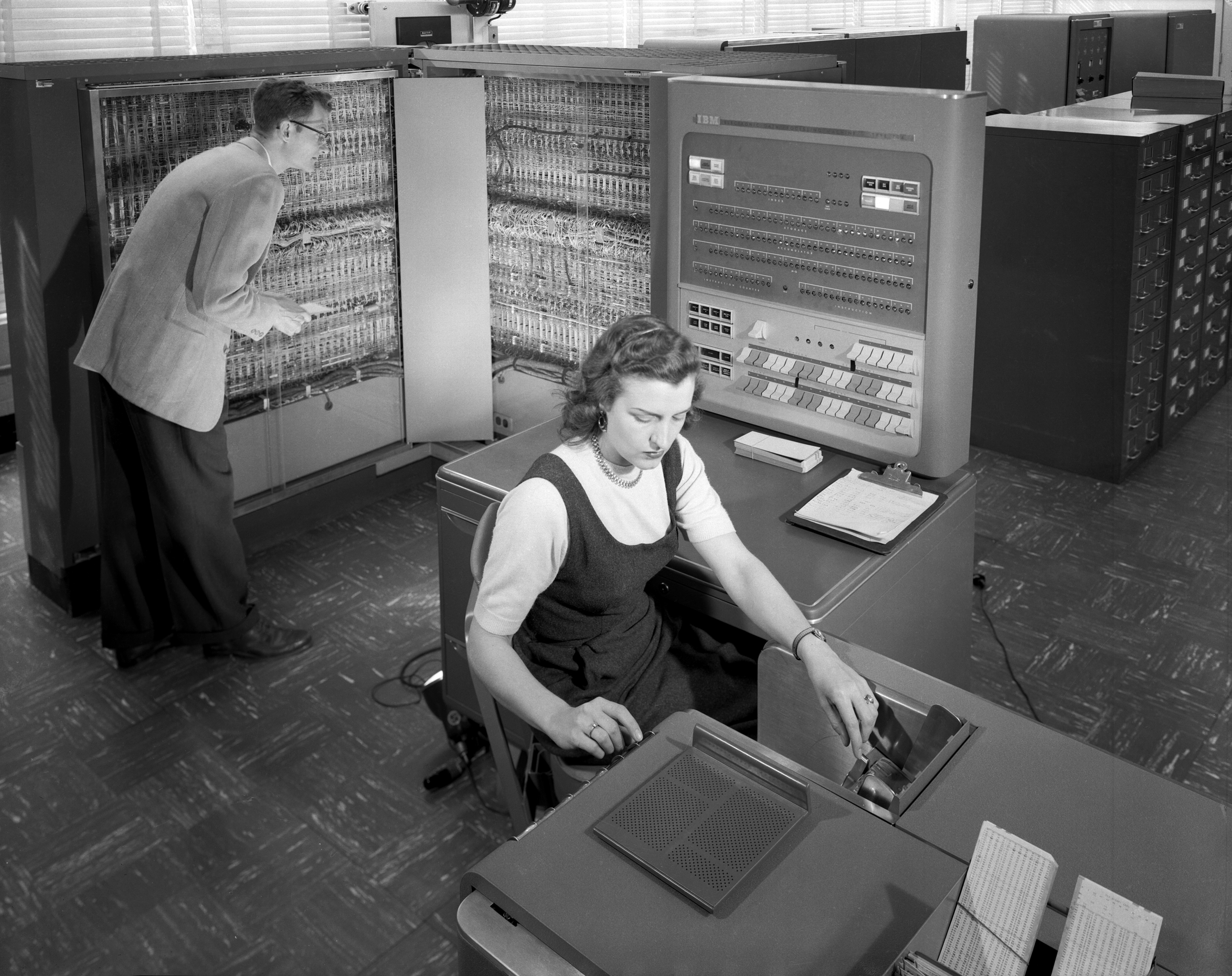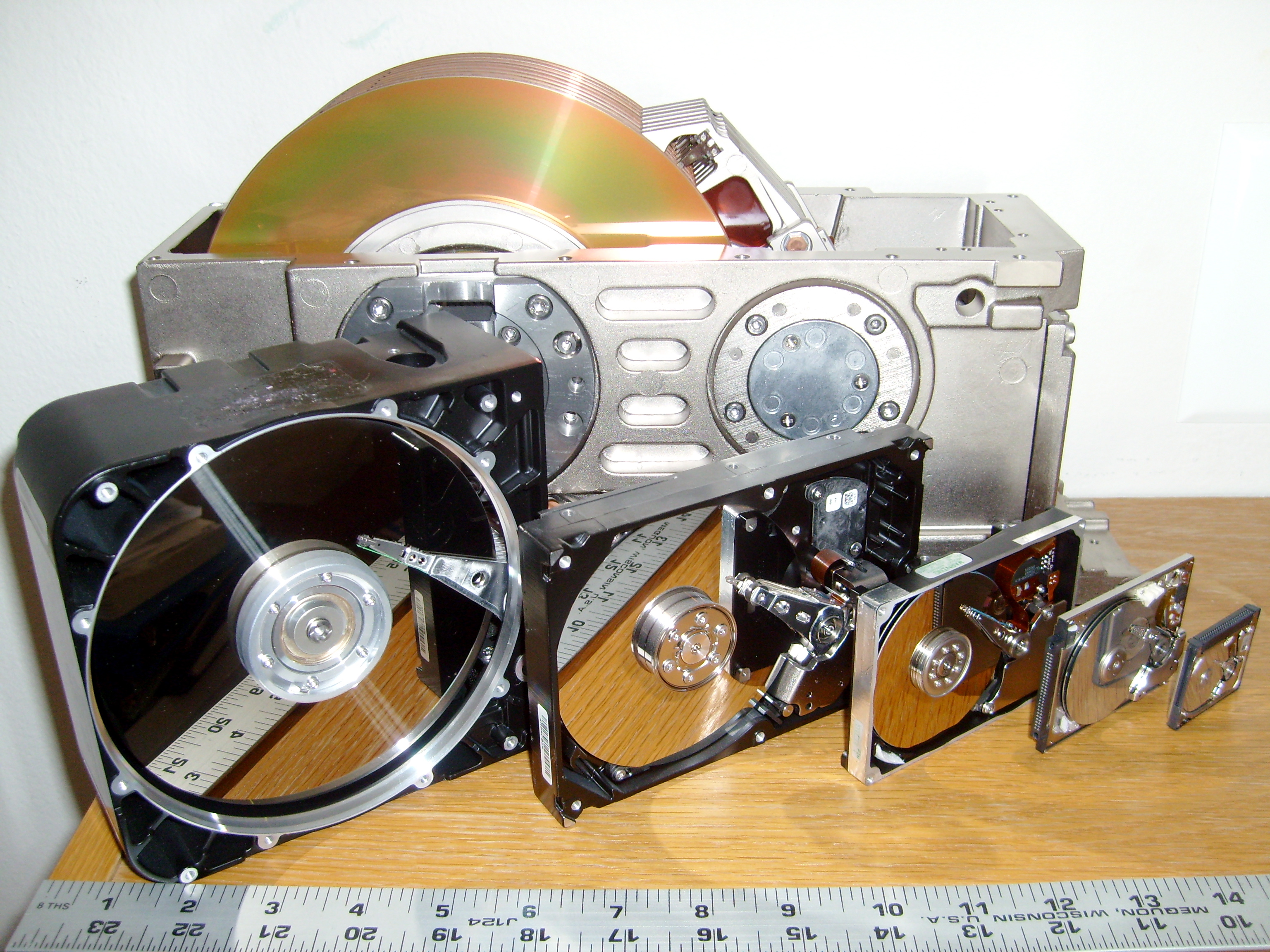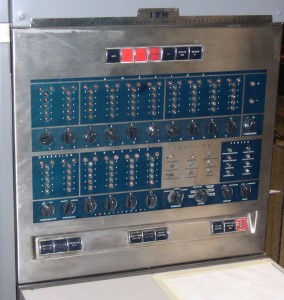|
IBM Mainframes
IBM mainframes are large computer systems produced by IBM since 1952. During the 1960s and 1970s, IBM dominated the large computer market. Current mainframe computers in IBM's line of business computers are developments of the basic design of the IBM System/360. First and second generation From 1952 into the late 1960s, IBM manufactured and marketed several large computer models, known as the IBM 700/7000 series. The first-generation 700s were based on vacuum tubes, while the later, second-generation 7000s used transistors. These machines established IBM's dominance in electronic data processing ("EDP"). IBM had two model categories: one (701, 704, 709, 7030, 7090, 7094, 7040, 7044) for engineering and scientific use, and one (702, 705, 705-II, 705-III, 7080, 7070, 7072, 7074, 7010) for commercial or data processing use. The two categories, scientific and commercial, generally used common peripherals but had completely different instruction sets, and there were incompatibiliti ... [...More Info...] [...Related Items...] OR: [Wikipedia] [Google] [Baidu] |
Mainframe Computer
A mainframe computer, informally called a mainframe or big iron, is a computer used primarily by large organizations for critical applications like bulk data processing for tasks such as censuses, industry and consumer statistics, enterprise resource planning, and large-scale transaction processing. A mainframe computer is large but not as large as a supercomputer and has more processing power than some other classes of computers, such as minicomputers, servers, workstations, and personal computers. Most large-scale computer-system architectures were established in the 1960s, but they continue to evolve. Mainframe computers are often used as servers. The term ''mainframe'' was derived from the large cabinet, called a ''main frame'', that housed the central processing unit and main memory of early computers. Later, the term ''mainframe'' was used to distinguish high-end commercial computers from less powerful machines. Design Modern mainframe design is characterized less b ... [...More Info...] [...Related Items...] OR: [Wikipedia] [Google] [Baidu] |
IBSYS
IBSYS is the discontinued tape-based operating system that IBM supplied with its IBM 709, IBM 7090 and IBM 7094 computers. A similar operating system (but with several significant differences), also called IBSYS, was provided with IBM 7040 and IBM 7044 computers. IBSYS was based on FORTRAN Monitor System (FMS) and (more likely) Bell Labs' "BESYS" rather than the SHARE Operating System. IBSYS directly supported several old language processors on the $EXECUTE card: 9PAC, FORTRAN and IBSFAP. Newer language processors ran under IBJOB. IBM later provided similar facilities for the 7040/7044 as IBM 7040/7044 Operating System (16K/32K) 7040-PR-150 and for the IBM 1410/IBM 7010 as IBM 1410/7010 Operating System 1410-PR-155. IBSYS System Supervisor IBSYS itself is a resident monitor program, that reads control card images placed between the decks of program and data cards of individual jobs. An IBSYS control card begins with a "$" in column 1, immediately followed by a ''Control ... [...More Info...] [...Related Items...] OR: [Wikipedia] [Google] [Baidu] |
IBM System/7
The IBM System/7 was a computer system designed for industrial control, announced on October 28, 1970 and first shipped in 1971. It was a 16-bit machine and one of the first made by IBM to use novel semiconductor memory, instead of magnetic core memory conventional at that date. IBM had earlier products in industrial control market, notably the IBM 1800 which appeared in 1964. However, there was minimal resemblance in architecture or software between the 1800 series and the System/7. System/7 was designed and assembled in Boca Raton, Florida. Hardware architecture The processor designation for the system was IBM 5010. There were 8 registers which were mostly general purpose (capable of being used equally in instructions) although R0 had some extra capabilities for indexed memory access or system I/O. Later models may have been faster, but the versions existing in 1973 had register to register operation times of 400 ns, memory read operations at 800 ns, memory wri ... [...More Info...] [...Related Items...] OR: [Wikipedia] [Google] [Baidu] |
EBCDIC
Extended Binary Coded Decimal Interchange Code (EBCDIC; ) is an eight-bit character encoding used mainly on IBM mainframe and IBM midrange computer operating systems. It descended from the code used with punched cards and the corresponding six-bit binary-coded decimal code used with most of IBM's computer peripherals of the late 1950s and early 1960s. It is supported by various non-IBM platforms, such as Fujitsu-Siemens' BS2000/OSD, OS-IV, MSP, and MSP-EX, the SDS Sigma series, Unisys VS/9, Unisys MCP and ICL VME. History EBCDIC was devised in 1963 and 1964 by IBM and was announced with the release of the IBM System/360 line of mainframe computers. It is an eight-bit character encoding, developed separately from the seven-bit ASCII encoding scheme. It was created to extend the existing Binary-Coded Decimal (BCD) Interchange Code, or BCDIC, which itself was devised as an efficient means of encoding the two ''zone'' and ''number'' punches on punched cards into six bits. ... [...More Info...] [...Related Items...] OR: [Wikipedia] [Google] [Baidu] |
IBM 1130
The IBM 1130 Computing System, introduced in 1965, was IBM's least expensive computer at that time. A binary 16-bit machine, it was marketed to price-sensitive, computing-intensive technical markets, like education and engineering, succeeding the decimal IBM 1620 in that market segment. Typical installations included a 1 megabyte disk drive that stored the operating system, compilers and object programs, with program source generated and maintained on punched cards. Fortran was the most common programming language used, but several others, including APL, were available. The 1130 was also used as an intelligent front-end for attaching an IBM 2250 Graphics Display Unit, or as remote job entry (RJE) workstation, connected to a System/360 mainframe. Description The total production run of the 1130 has been estimated at 10,000. The 1130 holds a place in computing history because it (and its non-IBM clones) gave many people their first direct interaction with a computer. Its pri ... [...More Info...] [...Related Items...] OR: [Wikipedia] [Google] [Baidu] |
IBM 1620
The IBM 1620 was announced by IBM on October 21, 1959, and marketed as an inexpensive scientific computer. After a total production of about two thousand machines, it was withdrawn on November 19, 1970. Modified versions of the 1620 were used as the CPU of the IBM 1710 and IBM 1720 Industrial Process Control Systems (making it the first digital computer considered reliable enough for real-time process control of factory equipment). Being variable-word-length decimal, as opposed to fixed-word-length pure binary, made it an especially attractive first computer to learn on and hundreds of thousands of students had their first experiences with a computer on the IBM 1620. Core memory cycle times were 20 microseconds for the (earlier) Model I, 10 microseconds for the Model II (about a thousand times slower than typical computer main memory in 2006). The Model II was introduced in 1962. Architecture Memory The IBM 1620 was a variable "word" length decimal ( BCD) computer with a mag ... [...More Info...] [...Related Items...] OR: [Wikipedia] [Google] [Baidu] |
IBM 1400 Series
The IBM 1400 series were second-generation (transistor) mid-range business decimal computers that IBM marketed in the early 1960s. The computers were offered to replace tabulating machines like the IBM 407. The 1400-series machines stored information in magnetic cores as variable-length character strings separated on the left by a special bit, called a "wordmark," and on the right by a "record mark." Arithmetic was performed digit-by-digit. Input and output support included punched card, magnetic tape, and high-speed line printers. Disk storage was also available. Many members of the series could be used as independent systems, as extensions to IBM punched-card equipment, or as auxiliary equipment to other computer systems. Some, however, were intended for specific applications or were economical only as independent systems. History The 1401, announced on October 5, 1959, was the first member of the IBM 1400 series. It was the first computer to deploy over 10,000 units. Th ... [...More Info...] [...Related Items...] OR: [Wikipedia] [Google] [Baidu] |
Early IBM Disk Storage
IBM manufactured magnetic disk storage devices from 1956 to 2003, when it sold its hard disk drive business to Hitachi. Both the hard disk drive (HDD) and floppy disk drive (FDD) were invented by IBM and as such IBM's employees were responsible for many of the innovations in these products and their technologies. The basic mechanical arrangement of hard disk drives has not changed since the IBM 1301. Disk drive performance and characteristics are measured by the same standards now as they were in the 1950s. Few products in history have enjoyed such spectacular declines in cost and physical size along with equally dramatic improvements in capacity and performance. IBM manufactured 8-inch floppy disk drives from 1969 until the mid-1980s, but did not become a significant manufacturer of smaller-sized, 5.25- or 3.5-inch floppy disk drives (the dimension refers to the diameter of the floppy disk, not the size of the drive). IBM always offered its magnetic disk drives for sale but did no ... [...More Info...] [...Related Items...] OR: [Wikipedia] [Google] [Baidu] |
Disk Storage
Disk storage (also sometimes called drive storage) is a general category of storage mechanisms where data is recorded by various electronic, magnetic, optical, or mechanical changes to a surface layer of one or more rotating disks. A disk drive is a device implementing such a storage mechanism. Notable types are the hard disk drive (HDD) containing a non-removable disk, the floppy disk drive (FDD) and its removable floppy disk, and various optical disc drives (ODD) and associated optical disc media. (The spelling ''disk'' and ''disc'' are used interchangeably except where trademarks preclude one usage, e.g. the Compact Disc logo. The choice of a particular form is frequently historical, as in IBM's usage of the ''disk'' form beginning in 1956 with the " IBM 350 disk storage unit".) Background Audio information was originally recorded by analog methods (see Sound recording and reproduction). Similarly the first video disc used an analog recording method. In the music indu ... [...More Info...] [...Related Items...] OR: [Wikipedia] [Google] [Baidu] |
IBM 305 RAMAC
The IBM 305 RAMAC was the first commercial computer that used a moving-head hard disk drive (magnetic disk storage) for secondary storage. The system was publicly announced on September 14, 1956,650 RAMAC announcement The 305 RAMAC and the 650 RAMAC were internally announced on September 4, 1956. with test units already installed at the U.S. Navy and at private corporations. RAMAC stood for "Random Access Method of Accounting and Control", as its design was motivated by the need for real-time accounting in business.IBM RAMAC promotional film /ref> History The first RAMAC to be used in the U.S. auto indu ...[...More Info...] [...Related Items...] OR: [Wikipedia] [Google] [Baidu] |
Drum Memory
Drum memory was a magnetic data storage device invented by Gustav Tauschek in 1932 in Austria. Drums were widely used in the 1950s and into the 1960s as computer memory. For many early computers, drum memory formed the main working memory of the computer. It was so common that these computers were often referred to as ''drum machines''. Some drums were also used as secondary storage as for example various IBM drum storage drives. Drums were displaced as primary computer memory by magnetic core memory, which offered a better balance of size, speed, cost, reliability and potential for further improvements. Drums in turn were replaced by hard disk drives for secondary storage, which were both less expensive and offered denser storage. The manufacturing of drums ceased in the 1970s. Technical design A drum memory or drum storage unit contained a large metal cylinder, coated on the outside surface with a ferromagnetic recording material. It could be considered the precu ... [...More Info...] [...Related Items...] OR: [Wikipedia] [Google] [Baidu] |
Decimal Architecture
Decimal computers are computers which can represent numbers and addresses in decimal as well as providing instructions to operate on those numbers and addresses directly in decimal, without conversion to a pure binary representation. Some also had a variable wordlength, which enabled operations on numbers with a large number of digits. Early computers Early computers that were exclusively decimal include the ENIAC, IBM NORC, IBM 650, IBM 1620, IBM 7070, UNIVAC Solid State 80. In these machines, the basic unit of data was the decimal digit, encoded in one of several schemes, including binary-coded decimal (BCD), bi-quinary and two-out-of-five code. Except for the IBM 1620 and 1710, these machines used word addressing. When non-numeric characters were used in these machines, they were encoded as two decimal digits. Other early computers were character oriented, providing instructions for performing arithmetic on character strings of decimal numerals, using BCD or excess-3 (XS- ... [...More Info...] [...Related Items...] OR: [Wikipedia] [Google] [Baidu] |


.jpg)





.jpg)

